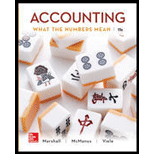
Accounting: What the Numbers Mean
11th Edition
ISBN: 9781259535314
Author: David Marshall, Wayne William McManus, Daniel Viele
Publisher: McGraw-Hill Education
expand_more
expand_more
format_list_bulleted
Concept explainers
Textbook Question
Chapter 6, Problem 6.20E
Exercise 6.20
LO 3, 4, 6, 8
Transaction analysis-various accounts Prepare an answer sheet with the following column headings. For each of the following transactions or adjustments, indicate the effect of the transaction or adjustment on assets, liabilities, and net income by entering for each account affected the account name and amount and indicating whether it is an addition (+) or a subtraction (-). Transaction a has been done as an illustration. Net income is not affected by every transaction. In some cases, only one column may be affected because all of the specific accounts affected by the transaction are included in that category.
| a. | Assets | Liabilities | Net Income |
| Recorded $600 | Accumulated | Depreciation | |
| of depreciation | Depreciation | Expense | |
| expense. | -600 | -600 |
- Sold land that had originally cost $117,000 for $102,600 in cash.
- Recorded a $612,000 payment for the cost of developing and registering a patent.
- Recognized periodic amortization for the patent (in part c) using the maximum statutory useful life.
- Capitalized 328,800 of cash expenditures made to extend the useful life of production equipment.
- Expensed $14,100 of cash expenditures incurred for routine maintenance of production equipment.
- Sold a used machine for $81,000 in cash. The machine originally cost $270,000 and had been
depreciated for the first two years of its five-year useful life using the double-declining-balance method. (Hint: You must compute the balance of the accumulated depreciation account before you can record the sale.) - Purchased a business for $2,800,000 in cash. The fair values of the net assets acquired were as follows: Land, $400,000; Buildings, $1,800,000; Equipment, $900,000; and Long-Term Debt, $600,000.
Expert Solution & Answer
Want to see the full answer?
Check out a sample textbook solution
Students have asked these similar questions
Abc ?
abc general accounting
Round to the nearest day
Chapter 6 Solutions
Accounting: What the Numbers Mean
Ch. 6 - Prob. 6.1MECh. 6 - Prob. 6.2MECh. 6 - Mini-Exercise 6.3 LO 3 Depreciation calculation...Ch. 6 - Prob. 6.4MECh. 6 - Mini-Exercise 6.5 LO 9 Goodwill Backstreets Co....Ch. 6 - Prob. 6.6MECh. 6 - Exercise 6.7 LO 1 Basket purchase allocation...Ch. 6 - Prob. 6.8ECh. 6 - Prob. 6.9ECh. 6 - Prob. 6.10E
Ch. 6 - Exercise 6.11 LO 3 Effect of depreciation on ROI...Ch. 6 - Exercise 6.12 LO 3 Financial statement effects of...Ch. 6 - Exercise 6.13 LO 3 Depreciation calculation...Ch. 6 - Exercise 6.14 LO 3 Depreciation calculation...Ch. 6 - Prob. 6.15ECh. 6 - Prob. 6.16ECh. 6 - Prob. 6.17ECh. 6 - Exercise 6.18 LO 9 Goodwill-effect on ROI and...Ch. 6 - Exercise 6.19 LO 6, 8, 9 Transaction...Ch. 6 - Exercise 6.20 LO 3, 4, 6, 8 Transaction...Ch. 6 - Prob. 6.21PCh. 6 - Prob. 6.22PCh. 6 - Prob. 6.23PCh. 6 - Problem 6.24 LO 3 Partial-year depreciation...Ch. 6 - Problem 6.25
LO 3
Identify depreciation methods...Ch. 6 - Prob. 6.26PCh. 6 - Prob. 6.27PCh. 6 - Prob. 6.28PCh. 6 - Prob. 6.29PCh. 6 - Prob. 6.30PCh. 6 - Prob. 6.31PCh. 6 - Prob. 6.32PCh. 6 - Prob. 6.33CCh. 6 - Prob. 6.34CCh. 6 - Case 6.35 LO 3, 6 Capstone analytical review of...
Knowledge Booster
Learn more about
Need a deep-dive on the concept behind this application? Look no further. Learn more about this topic, accounting and related others by exploring similar questions and additional content below.Similar questions
- A boiler maintenance team services a design capacity of 8 boilers per day with an effective capacity of 8 boilers per day. What is the team's utilization if it repairs an average of 5 boilers per day?solve thisarrow_forwardAccounting 45arrow_forwardBrandi Manufacturing estimates manufacturing overhead of $3,500,000 for 2024 and will apply overhead to units produced based on 800,000 machine hours. During 2024, Brandi used $1,850,000 of raw materials, paid $5,210,000 in direct labor, generated 790,000 machine hours, and produced 2,500,000 units. Required: Calculate Brandi's predetermined overhead rate and cost per unit of production for 2024.arrow_forward
arrow_back_ios
SEE MORE QUESTIONS
arrow_forward_ios
Recommended textbooks for you
- Principles of Accounting Volume 1AccountingISBN:9781947172685Author:OpenStaxPublisher:OpenStax College
 Financial Accounting: The Impact on Decision Make...AccountingISBN:9781305654174Author:Gary A. Porter, Curtis L. NortonPublisher:Cengage Learning
Financial Accounting: The Impact on Decision Make...AccountingISBN:9781305654174Author:Gary A. Porter, Curtis L. NortonPublisher:Cengage Learning Auditing: A Risk Based-Approach (MindTap Course L...AccountingISBN:9781337619455Author:Karla M Johnstone, Audrey A. Gramling, Larry E. RittenbergPublisher:Cengage Learning
Auditing: A Risk Based-Approach (MindTap Course L...AccountingISBN:9781337619455Author:Karla M Johnstone, Audrey A. Gramling, Larry E. RittenbergPublisher:Cengage Learning  Intermediate Financial Management (MindTap Course...FinanceISBN:9781337395083Author:Eugene F. Brigham, Phillip R. DavesPublisher:Cengage Learning
Intermediate Financial Management (MindTap Course...FinanceISBN:9781337395083Author:Eugene F. Brigham, Phillip R. DavesPublisher:Cengage Learning

Principles of Accounting Volume 1
Accounting
ISBN:9781947172685
Author:OpenStax
Publisher:OpenStax College

Financial Accounting: The Impact on Decision Make...
Accounting
ISBN:9781305654174
Author:Gary A. Porter, Curtis L. Norton
Publisher:Cengage Learning

Auditing: A Risk Based-Approach (MindTap Course L...
Accounting
ISBN:9781337619455
Author:Karla M Johnstone, Audrey A. Gramling, Larry E. Rittenberg
Publisher:Cengage Learning

Intermediate Financial Management (MindTap Course...
Finance
ISBN:9781337395083
Author:Eugene F. Brigham, Phillip R. Daves
Publisher:Cengage Learning
ACCOUNTING BASICS: Debits and Credits Explained; Author: Accounting Stuff;https://www.youtube.com/watch?v=VhwZ9t2b3Zk;License: Standard Youtube License